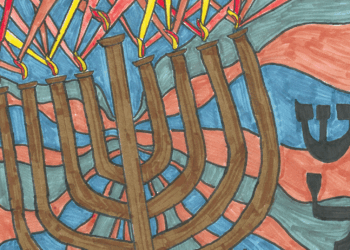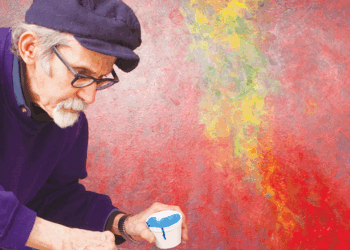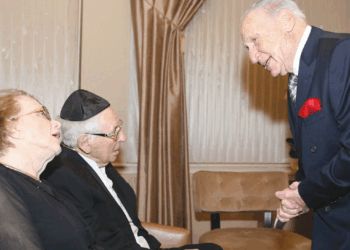Islamic influence on Jewish art is prevalent in the variety of items on display
By DORIS RUBENSTEIN
Back in 1981 or so, I took a Royal Air Maroc flight from New York City to Montreal. What I thought would be an uneventful trip turned out to be a cultural and historic adventure.
The flight was full of lively, talkative Moroccans. The women were dressed in high fashion and wore tremendous amounts of gold jewelry. When I got up to use the restroom, I could not help but notice that the woman exiting was wearing a large, gold Magen David. When I looked at the rest of the women more closely, I saw that all of their golden jewelry was Jewish stars, mezuzot and hamsas; some women were wearing five or six necklaces, and bracelets with Jewish designs as well.
I later learned that this was a refugee flight — these Moroccan Jews had fled the country of their birth when a wave of anti-Semitism and anti-Zionism was sweeping the land. They were not allowed to take money out of the country, hence the women bore their wealth around their necks and arms to a friendly, francophone place where they could monetize their golden treasure and make a new home.
What they also may have carried with them were Jewish ritual objects, some examples of which are currently exhibited in the Minneapolis Institute of Arts’ Harold and Mickey Smith Gallery of Jewish Arts and Culture. The show displays artifacts not just from Morocco, but also from across the Sephardic world: North Africa, Turkey and other areas of the Middle East; wherever the Jews settled after being expelled from Spain and Portugal on Tisha B’Av 1492.
 Among the Jewish ritual objects on display is an 1879 ketuba from Iran that uses classical Persian imagery of lions with sunbursts. (Photo: Courtesy of Minneapolis Institute of Arts)
Among the Jewish ritual objects on display is an 1879 ketuba from Iran that uses classical Persian imagery of lions with sunbursts. (Photo: Courtesy of Minneapolis Institute of Arts)
The Islamic influence on Jewish art didn’t begin with the expulsion from Spain. The “Golden Age of Spain,” which included a golden age of Jewish art and literature, was the Islamic caliphate in the Iberian peninsula during the Middle Ages. Jews, while still second-class citizens under the Muslims, experienced a freedom and acceptance unknown in Europe at that time — a freedom that was not equaled again until the mid-20th century with the establishment of the State of Israel.
The majority of the ritual objects exhibited in Way of the Sephardim: Judaica from the Sephardic Tradition date from the mid-1800s onward; there still is a sampling of earlier creations such as a reproduction of the famous 14th-century Barcelona Haggada. Be it a simple silver Kiddush cup with plate and lid from Iraq, or a brass and silver inlaid Ner Tamid, the Islamic influence is visible. The decorations carry motifs that recall those at the Taj Mahal and the Al Aqsar Mosque: stylized calligraphy, geometrical designs, birds, flowers and plants predominate.
But these are Jewish objects. The Ner Tamid, from Syria, is not just an Islamic-designed oil lamp. If you look closely, you can see that there are engravings of people — biblical figures — that would never appear on an Islamic object. The Sephardim didn’t need to play by those rules.
Conversely, the 1879 ketuba from Iran uses classical Persian imagery of lions with sunbursts to decorate the document. This may reflect the dual identity that Sephardim, who by then had lived nearly 400 years in Iran, felt toward their home in the Diaspora. It’s as if an American couple chose to include an image of Uncle Sam on their marriage contract.
Also from Iran is a simple brass tzedaka box made in the 1800s. The box is in the shape of a small house — or is it a beit midrash that is being supported by the donations? In either case, it gives today’s viewer a peek at how humble Persian Jewish architecture was at that time.
Way of the Sephardim has objects that are familiar in function, if not in form or execution, to most Ashkenazim. An early 20th-century yad from Morocco lacks the familiar pointed finger. The tik (Torah case) from Baghdad is timeless and classic in design. Rimonim (dowel finials) from Morocco of intricate filigree have narrow openings because they do not sit on the scroll’s rollers directly as they do in the European tradition; rather, they are placed on special holders near the top of the tik.
Most of the ritual objects appear to have been used in homes or synagogues. Not so for a Purim grogger from India — it is made of ivory and most certainly belonged to a wealthy Jew who wished to display his status.
Several items in the show are from the private collection of Harold Smith and his late wife, Mickey, for whom the MIA’s Judaica gallery is named.
“Mickey and I always looked for places of Jewish interest when we traveled,” Smith said. “We found items that were attractive to us and bought them. Now, we want the whole community to enjoy them, too.”
And the community says thank you.
***
Way of the Sephardim: Judaica from the Sephardic Tradition is on display through April 22, 2012, in the Harold and Mickey Smith Gallery of Jewish Arts and Culture at the Minneapolis Institute of Arts, 2400 Third Ave. S. For information, visit: www.artsmia.org.

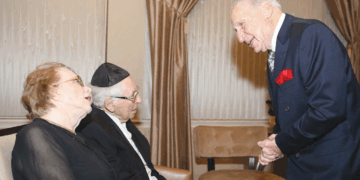

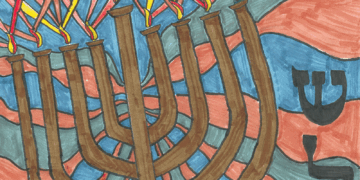




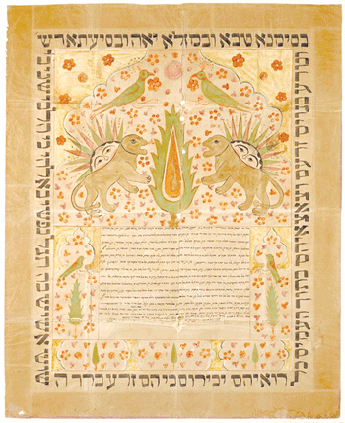 Among the Jewish ritual objects on display is an 1879 ketuba from Iran that uses classical Persian imagery of lions with sunbursts. (Photo: Courtesy of Minneapolis Institute of Arts)
Among the Jewish ritual objects on display is an 1879 ketuba from Iran that uses classical Persian imagery of lions with sunbursts. (Photo: Courtesy of Minneapolis Institute of Arts)
